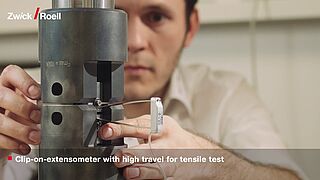Fracture Toughness Testing to ASTM E399/ISO 12135: How to Reduce Costs and Complexity
Two types of tests – one system: The smartest path to KIC determination
When it comes to the material safety, knowing the maximum tensile strength is no longer enough. What really matters is: How does a material respond when exposed to defects – such as small cracks caused by manufacturing or mechanical loads? This is exactly where fracture mechanics comes in. One of the most important standards in this area is ASTM E399, which deals with what is known as the critical stress intensity factor KIC.
This value describes how resistant a crack-affected material is to unstable crack propagation – i.e., how high the intensity of the stress field near the crack tip may be before it suddenly fails. This key figure is crucial, especially in safety-critical applications, such as in aerospace, in automotive engineering or energy technology.
What exactly does ASTM E399 test?
ASTM E399 defines the test conditions to determine the fracture toughness value KIC under linear elastic conditions. What makes it unique: Standardized specimens are used – usually CT (compact tension) or SEB (single edge bend) specimens – which specifically contain predefined cracks. These are led to fracture under quasi-static loading, whereby the stress intensity at the crack is evaluated.
The prerequisites for valid results are:
- A linear elastic material behavior
- A "natural" crack with certain properties (i.e. sharp with a certain crack length and defined preceding stress field)
- A precisely controlled test procedure
- A careful evaluation compliant to standard specifications
And this is exactly where it becomes clear: ASTM E399 is anything but a simple standard test. The demands on the machine, software and user are high – and the time required for many specimens can be significant.
The vibrophore: efficiency meets precision
ZwickRoell offers a solution in its portfolio with the vibrophore, originally developed for fatigue testing (e.g. S-N curves according to DIN 50100) But with a clever additional benefit: By mechanically blocking the resonator, the vibrophore can also be used for quasi-static tests – making it ideal for ASTM E399.
The benefits speak for themselves:
- Two test methods, one system: Fatigue tests and fracture toughness tests in one machine
- Energy-efficient: In resonance mode, the vibrophore requires only about 2% of the energy of a comparable servohydraulic machine
- Low maintenance: No hydraulic system, no oil, no cooling unit
- Quiet and clean: Ideal for laboratory environments without disturbing noises or oil mist
- Automated evaluation: With the testing software testXpert, ASTM E399 compliant results can be directly documented and archived
An example from the field
In many testing laboratories – for example in metalworking companies or at aviation industry suppliers – both fatigue and fracture mechanics tests are regularly performed. Instead of maintaining two systems, the vibrophore can be used as your multi-talented solution: During the day, quasi-static KIC tests according to ASTM E399 run and at night, S-N curves in continuous loop operation. The change between the operating modes takes place without tools – it could hardly be more efficient.
Especially with high quantities or tight schedules, this flexibility has a positive effect on utilization and operating costs. The training required is also lower, as testing personnel only have to be familiar with one system.
Thoughtfully designed. Economically smart.
In terms of total operating costs, the vibrophore scores particularly well. While conventional servohydraulic systems are not only expensive to use, but also require regular maintenance (e.g. oil changes, filters, valves) and complex cooling, the vibrophore remains:
- Low-maintenance (hardly any mechanically stressed parts)
- Space-saving (no additional power packs)
- And cost-efficient in the long term
Conclusion: ASTM E399 with the vibrophore – smarter testing
Fracture mechanics is challenging – technically, standardly and organizationally. If you want to work efficiently and in a future-proof manner, the vibrophore is hard to ignore. The option of performing both dynamic and quasi-static tests on a single machine reduces investment and operating costs while increasing flexibility in the testing laboratory.
With ZwickRoell and the vibrophore, you are optimally equipped for all fracture mechanics challenges – from ASTM E399 to ISO 12106 to fatigue tests.

